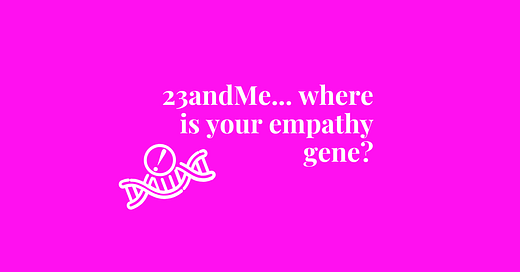Where’s Your Empathy Gene? Inside 23andMe’s Bankruptcy Press Release
From a crisis communications perspective
23andMe, a well-known and widely used direct-to-consumer genetic testing company that has been having problems for a while, has entered bankruptcy proceedings. Anne Wojcicki, 23andMe’s co-founder and long-time CEO, has stepped down as the company seeks a buyer through a court-managed process.
Approximately 15 million people have entrusted 23andMe with their genetic profiles and, implicitly, those of their relatives. Naturally, the company’s demise is raising substantial concerns about data privacy. But is 23andMe’s press release sufficient from a consumer perspective? Let’s talk about it.
The press release seems straightforward. The company is candid about its financial restructuring and leadership changes. But it is missing something. Empathy. A critical component of effective crisis responses, according to expert crisis strategist
.What 23andMe Got Right: Transparency and Speed
When a company is in crisis, its stakeholders need clarity. 23andMe understood this fundamental rule of crisis communications and delivered a timely, transparent announcement about its bankruptcy filing. Rather than obscuring their situation with vague or overly optimistic statements, they openly shared details of why a court-supervised process is their best route forward, emphasizing financial pressures and operational issues.
The company was quick to address what would likely be the most urgent question on their customer’s minds: the security and handling of their sensitive genetic data. Although their response wasn’t emotionally reassuring (more on this later), 23andMe explicitly stated that the way customer data are stored, managed, and protected would not change. Providing this information early can help contain speculation and prevent rumors, which many companies fail to do under pressure.
“There are no changes to the way the Company stores, manages, or protects customer data… In addition, we are committed to continuing to safeguard customer data and being transparent about the management of user data going forward, and data privacy will be an important consideration in any potential transaction.”
Additionally, 23andMe’s announcement showed decisive internal accountability in announcing the immediate resignation of CEO Anne Wojcicki. This shows the public and investors that the company recognizes the seriousness of the situation and is prepared to make difficult leadership decisions to move forward effectively.
“23andMe is seeking authorization from the Court to commence a process to sell substantially all of its assets through a chapter 11 plan or pursuant to Section 363 of the U.S. Bankruptcy Code. If approved by the Court, the Company, with the assistance of an independent investment banker, would actively solicit qualified bids over a 45-day process. If multiple qualified bids are submitted during the Court-supervised sale process, the Company plans to conduct an auction to maximize the value of its assets. Any buyer will be required to comply with applicable law with respect to the treatment of customer data and any transaction will be subject to customary regulatory approvals, including, as applicable, approvals under the Hart-Scott-Rodino Act and the Committee on Foreign Investment in the United States.”
23andMe also provided clear steps regarding exactly how their bankruptcy proceedings would unfold. The press release informs stakeholders about the upcoming court-supervised sale, the planned auction process, and the timeline for accepting bids. Providing specifics like these reduces the uncertainty and gives stakeholders an idea of what to monitor as the company navigates its crisis.
Where 23andMe Fell Short: Empathy and Audience Understanding
Empathy isn’t optional in crisis communications. Customers need more than information. They need to feel seen, understood, and reassured. And empathy is noticeably absent in 23andMe’s bankruptcy announcement. This oversight is particularly significant given the deeply personal nature of their service. Genetic information is fundamentally tied to a person’s identity, privacy, and family history.
23andMe’s statement is clear about the logistics of their bankruptcy proceedings; however, the release is critically missing acknowledgment of their customers’ anxiety about the security of their genetic data—likely heightened by the fact that 23andMe has already experienced a data breach.
23andMe’s customers don’t need operational assurances. They need reassurance that 23andMe understands their concerns on a human level. The brief note that there would be "no changes" to data management processes falls significantly short of validating customers' legitimate fears and anxieties.
The message seems to prioritize employees, shareholders, investors, and regulators rather than addressing the real worries of those who have entrusted their most personal information to the company. This was a missed opportunity to validate customers’ real concerns and emotions and diffuse some of the tension surrounding privacy.
Furthermore, 23andMe failed to include information about how customers can permanently remove their information from the company’s database. This is possible. Effective crisis communications give clear instructions to affected parties. Customers would have benefitted greatly from explicit guidance on the steps they can personally take to protect their data, such as instructions on how to delete it. 23andMe could have significantly strengthened trust by proactively outlining this process.
Strategic but Detached
The major issue? The statement’s tone isn’t fully aligned with the emotional reality of the consumers. The press release is transparent and thorough from a corporate governance perspective but feels crafted for employees, investors, and the market, overlooking the customers. This detachment risks making customers feel their concerns are secondary, undermining trust.
What can you learn from this?
Customers don’t just want to know you’re fixing a problem. They want reassurance that you understand why they’re concerned. Missing this vital piece means your communications can come across as indifferent or dismissive.
- Lead with empathy and validate your customers’ emotional concerns
- Provide actionable guidance for your customers
- Align your messaging with your stakeholders’ emotions
If you face a similar high-stakes announcement, ask yourself this…
Is my empathy gene fully activated?




